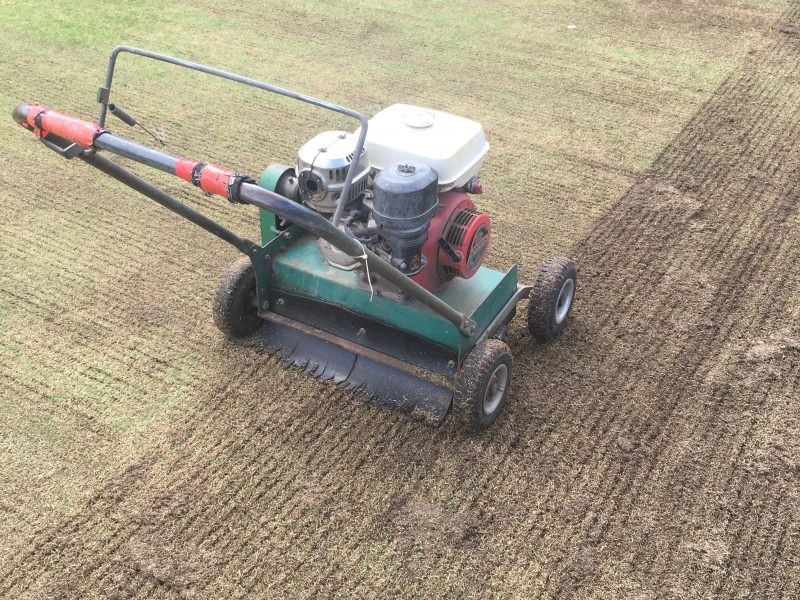When Is the Best Time of Year to Vertimow a Buffalo Lawn?

If you’re looking to maintain a lush, healthy Buffalo lawn, understanding when to perform key maintenance tasks is crucial. One such essential task is vertimowing Buffalo lawn, a process that removes thatch, improves air circulation, and stimulates growth. Knowing the right time of year to undertake vertimowing can make a significant difference in the overall health of your grass. In this guide, we will explore the best timing for vertimowing and offer practical tips from Care Lawn Service and Premier Lawns.
What Is Vertimowing and Why Is It Important?
Vertimowing, also known as lawn dethatching, involves using a specialized machine to cut vertical grooves into the soil. This process removes dead grass, moss, and other debris from the lawn’s surface, allowing nutrients, water, and sunlight to reach the roots more effectively. For Buffalo lawns, which are known for their thick, soft blades, vertimowing helps reduce compacted soil and encourages healthy growth throughout the season.
A well-vertimowed Buffalo lawn not only looks aesthetically pleasing but also becomes more resilient to pests, diseases, and dry conditions. Premier Lawns recommends regular vertimowing as part of a comprehensive lawn care program to maintain optimum turf health.
How Does Season Affect Vertimowing Buffalo Lawn?
Timing is everything when it comes to vertimowing Buffalo lawn. Unlike other grass types, Buffalo grass has specific growth periods that determine when vertimowing will be most effective. Buffalo grass is a warm-season turf, meaning it thrives during the warmer months and goes dormant during winter.
Performing vertimowing at the wrong time can stress your lawn and slow growth rather than improve it. Therefore, it is essential to align vertimowing with the natural growth cycle of your Buffalo lawn. Care Lawn Service often advises clients to avoid vertimowing during extreme heat or frosty periods, as this can damage the grass.
When Should You Vertimow a Buffalo Lawn?
The best time to vertimow Buffalo lawn is during its active growth phase, typically in late spring to early summer. During this period, temperatures are warm, and the grass has sufficient energy to recover quickly from the vertimowing process. Vertimowing during active growth ensures that your lawn heals efficiently and fills in any gaps left after the process.
Late spring is particularly ideal because it allows your Buffalo grass to strengthen before the peak summer heat, reducing the risk of stress or browning. Many lawn care experts, including Premier Lawns, suggest planning vertimowing after the first mowing of the season when the grass has begun to grow but hasn’t reached its full height.
What Signs Indicate Your Buffalo Lawn Needs Vertimowing?
Before scheduling a vertimowing session, look for signs that your Buffalo lawn may need attention:
- Thick Layer of Thatch: A dense layer of thatch (more than 1cm) can prevent water and nutrients from reaching the roots.
- Poor Drainage: Water pooling on the lawn indicates compacted soil that could benefit from vertimowing.
- Patchy Growth: Thin or uneven areas of grass suggest that the lawn needs stimulation to encourage regrowth.
- Moss or Algae Growth: Excess moss often indicates that nutrients are not penetrating the soil effectively.
Recognizing these signs early allows you to schedule vertimowing at the optimal time and prevent long-term damage.
How Often Should Buffalo Lawns Be Vertimowed?
Frequency depends on the condition of your lawn and environmental factors. For most healthy Buffalo lawns, vertimowing once or twice a year is sufficient. Over-vertimowing can stress the grass and potentially lead to weak growth.
Care Lawn Service recommends combining vertimowing with other maintenance activities such as aeration, fertilization, and regular mowing. This integrated approach ensures your lawn remains healthy and vibrant all year round.
What Are the Steps to Vertimow a Buffalo Lawn Properly?
Proper technique is essential when vertimowing Buffalo lawn to achieve the best results:
- Mow the Lawn First: Cut the grass to a manageable height to make vertimowing more effective.
- Set the Vertimower Correctly: Adjust the blades to lightly penetrate the soil without damaging roots.
- Vertimow in Multiple Directions: Running the machine in perpendicular directions ensures thorough dethatching.
- Collect Debris: Rake up excess thatch and moss to prevent it from smothering the grass.
- Water and Fertilize: Immediately water and fertilize the lawn to encourage recovery and new growth.
Following these steps will maximize the benefits of vertimowing while keeping your Buffalo lawn healthy.
Why Professional Lawn Services Recommend Timing Vertimowing Carefully
While DIY vertimowing is possible, professional advice often yields the best outcomes. Premier Lawns emphasizes that timing, technique, and aftercare are critical for a successful Buffalo lawn vertimowing. Professionals can assess your lawn’s condition, recommend the right equipment settings, and provide tailored post-vertimowing care.
Additionally, professional services like Care Lawn Service can schedule vertimowing at the optimal seasonal window, ensuring your lawn gets the treatment it needs without risking stress or damage.
Can Vertimowing Be Done in Other Seasons?
Although late spring to early summer is ideal, there are secondary windows for vertimowing, depending on your climate:
- Autumn: Mild early autumn temperatures can allow for a second round of vertimowing. This timing helps prepare the lawn for winter dormancy.
- Avoid Winter and Extreme Heat: Vertimowing during winter or peak summer heat is risky. The lawn may be dormant or stressed, leading to slow recovery.
By choosing the correct season, you ensure that your Buffalo lawn benefits fully from vertimowing, creating a strong, lush turf year-round.
Integrating Vertimowing with Comprehensive Lawn Care
Vertimowing is just one part of a complete Buffalo lawn care strategy. To maintain the best results, combine vertimowing with:
- Regular Mowing: Keeps the grass at a healthy height and encourages thick growth.
- Aeration: Relieves soil compaction and improves nutrient uptake.
- Fertilization: Provides essential nutrients for strong root and blade development.
- Weed and Pest Control: Prevents competition and damage to your Buffalo grass.
This holistic approach, recommended by Premier Lawns, ensures a robust, healthy lawn that thrives in every season.
Conclusion: Timing Is Key for a Healthy Buffalo Lawn
In summary, the best time to vertimow Buffalo lawn is during its active growth period, typically late spring to early summer. Proper timing, combined with the correct technique and follow-up care, ensures your lawn remains thick, green, and resilient. By watching for signs such as thatch build-up, poor drainage, or patchy growth, you can schedule vertimowing at the most beneficial time.
Partnering with professional services like Care Lawn Service and Premier Lawns guarantees expert timing, precision, and aftercare, helping you achieve a beautiful, healthy Buffalo lawn throughout the year. Vertimowing at the right time not only improves the appearance of your lawn but also strengthens its health and longevity, making it a worthwhile investment in your property’s curb appeal.



